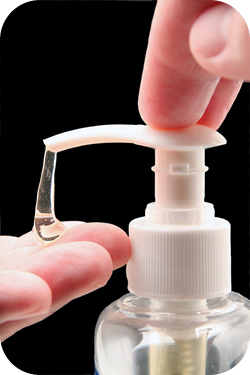Antibacterial Products
I get a lot of questions & calls about antibacterial products so I thought I’d address the topic (with assistance from Smart Mama’s Green Guide: Simple Steps to Reduce Your Child’s Toxic Chemical Exposure by Jennifer Taggart).
 Triclosan & triclocarban are the chemicals commonly used to give a product antibacterial properties. Triclosan is a chlorinated antimicrobial & antifungal pesticide and is found in at least 60% of our rivers & streams. It disrupts the aquatic environment & has been found to be harmful to the development of frogs including arrested physical development (tadpoles unable to transition into frogs). Also, it’s difficult for waste water treatment plants to handle the heavy loads of triclosan because it impacts the beneficial bacteria needed for the water treatment process.
Triclosan & triclocarban are the chemicals commonly used to give a product antibacterial properties. Triclosan is a chlorinated antimicrobial & antifungal pesticide and is found in at least 60% of our rivers & streams. It disrupts the aquatic environment & has been found to be harmful to the development of frogs including arrested physical development (tadpoles unable to transition into frogs). Also, it’s difficult for waste water treatment plants to handle the heavy loads of triclosan because it impacts the beneficial bacteria needed for the water treatment process.
To date, agencies have found triclosan to be safe. However, its regulatory status is complicated because products containing triclosan are regulated by the EPA, the FDA & the CPSC, all for different uses.
Environmental health-advocacy organizations have disagreed with the EPA’s risk assessment of triclosan including the contention that the assessment fails to take into account critical routes of exposure for infants & young children including breast milk, children’s personal care products, toys & clothing.
Triclosan’s disruptive effects shown in frogs have not been established in humans. But its chemical structure is similar to certain estrogens & so has the ability to act as an endocrine disruptor. Studies have shown that triclosan has adrogenic & estrogenic activity. Lab animal studies demonstrate that triclosan may affect the central nervous system & the immune system. It can result in contact dermititis, skin irritation & photoallergic contact dermatitis.
And, finally, triclosan & the chemicals that it breaks down into bioaccumulate in humans. A Swedish study found triclosan in human breast milk in three out of five women.
More problematic is that triclosan has been shown to react with chlorine, used to disinfect our water & form chloroform, a known carcinogen. Scientists have found that use of antibacterial soaps could result in an exposure to chloroform 10 to 40% above the EPA’s safe limit for tap water as compared with regular soaps. Whether this reaction could occur in a home has not been demonstrated.
Another poptential downside to using antibacterial products is that they may contribute to the risk of drug-resistant bacteria. According to Beyond Pesticides, “Evidence is mounting that links the use of triclosan-containing products with the promotion of bacteria resistant to antibiotic medications & antibacterial products.”
The real question that arises from this information is… Are we getting any benefit from the plethora of antibacterial products? And the answer appears to be, well, not really. Though there are numerous possible detrimental side effects.
Studies have shown that antibacterial products don’t provide any added benefit over using soap. Soap works by loosening & lifting dirt, oil & microbes from surfaces so they can easily be rinsed away by water. One study showed that regular soap & water killed 99.5% of microbes & antibacterial soap killed 99.6%.
If you feel the need to disinfect, or need something for on the go, try an alcohol-based cleaner or isopropyl alcohol. Alcohol-based cleaners inflect sweeping damage to cells by demolishing key structures then evaporate, leaving no residue. If you want to use antibacterial hand cleaner, use an alcohol-based hand sanitizer. Even better, try some of the natural sanitizers that rely on essential oils (like EO products, which we have at the shop).
With so many questions & the potential for extraordinary damage, why take the risk. Especially if there are healthy eco-friendly alternatives?


